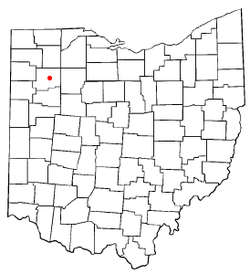2010 census
As of the census [12] of 2010, there were 1,001 people, 340 households, and 263 families living in the village. The population density was 617.9 inhabitants per square mile (238.6/km2). There were 351 housing units at an average density of 216.7 per square mile (83.7/km2). The racial makeup of the village was 98.3% White, 0.8% Asian, 0.1% from other races, and 0.8% from two or more races. Hispanic or Latino people of any race were 1.6% of the population.
There were 340 households, of which 40.6% had children under the age of 18 living with them, 70.3% were married couples living together, 4.7% had a female householder with no husband present, 2.4% had a male householder with no wife present, and 22.6% were non-families. 20.3% of all households were made up of individuals, and 10% had someone living alone who was 65 years of age or older. The average household size was 2.81 and the average family size was 3.30.
The median age in the village was 38.8 years. 28.6% of residents were under the age of 18; 5.9% were between the ages of 18 and 24; 24.1% were from 25 to 44; 25.6% were from 45 to 64; and 15.9% were 65 years of age or older. The gender makeup of the village was 47.3% male and 52.7% female.
2000 census
As of the census [5] of 2000, there were 919 people, 286 households, and 237 families living in the village. The population density was 599.4 inhabitants per square mile (231.4/km2). There were 297 housing units at an average density of 193.7 per square mile (74.8/km2). The racial makeup of the village was 98.59% White, 0.11% Asian, 0.44% from other races, and 0.87% from two or more races. Hispanic or Latino people of any race were 1.09% of the population.
There were 286 households, out of which 43.7% had children under the age of 18 living with them, 74.8% were married couples living together, 4.5% had a female householder with no husband present, and 16.8% were non-families. 15.7% of all households were made up of individuals, and 7.0% had someone living alone who was 65 years of age or older. The average household size was 2.93 and the average family size was 3.29.
In the village, the population was spread out, with 28.2% under the age of 18, 5.3% from 18 to 24, 29.3% from 25 to 44, 17.8% from 45 to 64, and 19.4% who were 65 years of age or older. The median age was 37 years. For every 100 females there were 93.5 males. For every 100 females age 18 and over, there were 88.0 males.
The median income for a household in the village was $52,083, and the median income for a family was $56,528. Males had a median income of $38,750 versus $25,500 for females. The per capita income for the village was $19,055. None of the families and 0.4% of the population were living below the poverty line, including no under eighteens and 3.1% of those over 64.






